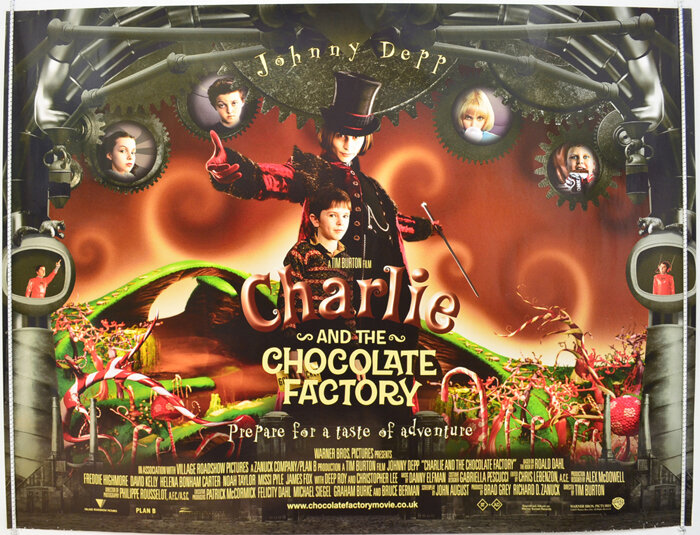
(Image: pastposters.com)
A Fantastic City of Chocolate
By Asucena Alvarado
In the world, people are producing many films that make our lives more enjoyable, and with each film, we can learn, dream, see the impossible, and believe that anything is possible in life. Even though we know there are some things that are just fantasy, but movies help us to think that everything could happen. A good example of a fantasy story is Charlie and the Chocolate Factory, where we can see that be humble and kind can give you a reward, but in the real world, we know this is not always true. Here, I want to make a deep research about the film and how the capitalization, the utopian vs dystopian and the past vs present are reflected in this movie, and how it is related to architecture.
To begin with, capitalization that is an important factor in the society, without capitalization, or money, life would be harder than what it is now. The capitalization helps us to have a better life, and unfortunately, it is what defines us in society. Also, the consumption and obsession come by hand with the capitalization. We see a clear example in the film Charlie and the Chocolate Factory, where people are obsessed with all kinds of things, not only with chocolate. For instance, Miguel is obsessed with video games and technologies, Veruca with all kinds of animals, Violet and her mom with all kinds of competencies and winning them, Augustus with food, and Charlie with the factory and its mysteries. Each character in the film has an obsession or has a kind of addiction to something. This film is showing a fantasy with clear examples of our daily life, examples of our reality. Sometimes we are obsessed with things to fulfill our interior, our life, but it is true that it will never fill out our inner emptiness because it is not the most important, but ourselves make it important in our lives. That is the reason we continue consuming all that we can have, thinking it will help us in the end. Here Tim Burton, the director of the film, is showing us a fantastic story with a happy ending, but also is showing us with each character, that there is much obsession in the world and that you can be obsessed with anything you like or you think is important in your life. For instance, at The Cabinet of Dr. Caligari film, we see an example of an obsession with the Dr. Caligari who is obsessed with the hypnosis, so he wanted to find a way to prove that with hypnosis many crimes can be done, and leave without punishment because he was not guilty. This was a way to fulfill his passion, even if other people lose their lives or their mind because Dr. Caligari thought it was important for him. We live in a world full of things that we think are necessary to live, and with this, we make all those things important in our lives to such an extent that they become an obsession.
Another obsession seen in the film Charlie and the Chocolate Factory is the obsession for the factory, and here is when we have a city within the city, or we can see the idea of a city moving with the factory. What I mean with this is that if something happens with the factory the city starts to move faster or slower. Just like in the Film of Berlin, Symphony of Great City, the city is moving with the people and the people are moving with the city according to the activities they are doing, making the city look like a real living species. We see this with Charlie, the main character, whose life is moving because of the mystery of the factory and his owner Willy Wonka. Charlie is gaining all his knowledge by his grandparents’ stories about the factory and the owner, but he had never seen Willy Wonka or someone from the factory, it is a mystery for him and for all the people in the city. But with a movement of the factory, all the people start to move and get crazy because all of them want to know what is inside and what is happening behind the factory bars. In the Dazed and Confused reading, the author Stan Allen said that Benjamin describes distraction as a bullet that hits the spectator, and it is the same with the factory which is hitting like a bullet to the people surrounding it. The factory is the focus of the city, the most important thing for the people in the town that is why people are so attentive to what is happening in the factory.
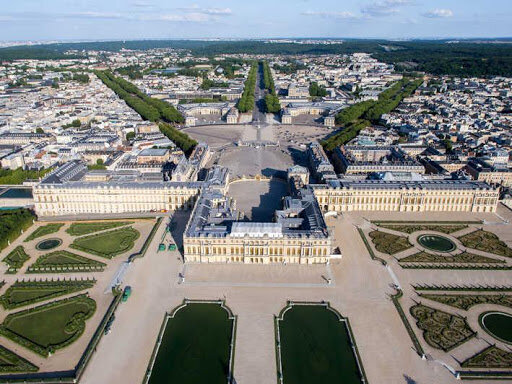
Figure 1
The theme of the film is a city with a factory, where the most important monument in the city is the factory, just like in the baroque cities. A good example of a baroque city is the Versailles city, in which the Palace of Versailles is the most important thing in the city, and it is shown in the architecture of the city. The grid of the city is organized to point the Palace, all streets going directly to the Palace giving great importance to it (Figure 1).
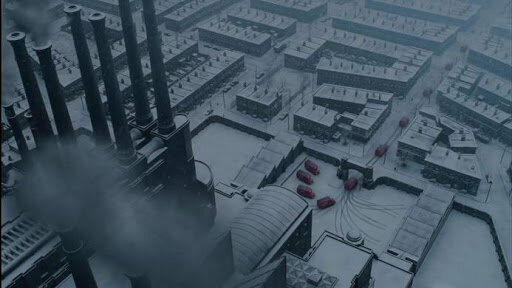
Figure 2
At the same time, at the film Charlie and the Chocolate Factory, the factory is very important and all the streets in the city are organized to go directly to the factory (figure 2). In addition, at Charlie and the Chocolate Factory, a clear example of Utopian and Dystopian is showed. The perfect contrast between utopian and dystopian. First, the city, outside the factory everything is gray, sad, not many colors are presented, everything is opaque, but when we get into the factory, we see bright colors and a perfect world inside a small factory, very utopian. In architecture, is important to create different contrasts to create unique monuments but is important to have a great mind and imagination. In the film, Charlie sees the factory as a perfect monument of imagination and creation because it is huge and awesome, and Charlie thinks that Willy Wonka is the factory himself (figure 3).
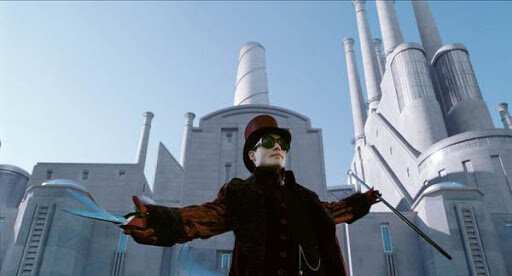
Figure 3
Willy is seen as someone huge and awesome that can create anything he wants. When we get inside the factory, we see different aspects that represent the magnificence of his creator, someone that is very intelligent and knew how to design a perfect factory. First, the big hallway, representing his big mind (figure 4) just as in the Blade Runner film, when Deckard is talking with Tyrell (the creator of replicants) we can see the tall of the walls and windows representing his greatness. It is the same with Willy Wonka, everything in the factory represents himself and his intelligence, even the Oompa-Loompas are small to not overshadow Willy’s greatness. Second, the great garden with the chocolate cascade (figure 5).
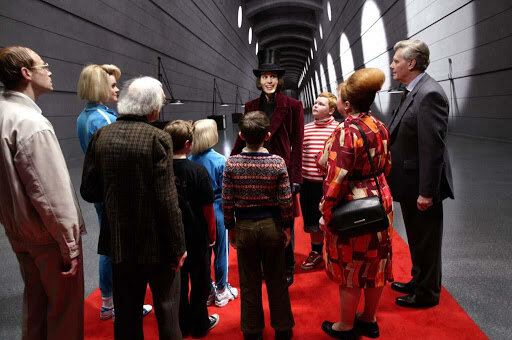
Figure 4
It is a perfect landscape inside the factory just to create the perfect chocolate and the perfect flavors for the other candies. Willy Wonka has a huge imagination and with it, he designs not only candies, flavors, and chocolate, but he designs a perfect place for his creations. We all have intelligence but is necessarily know how to use it and create amazing things, like Tyrell invented the artificial life with the replicants, Mr. Fredersen who create the perfect city for his son, and Willy Wonka, who create the perfect factory to create the perfect candies, and with them create happiness. Anything is possible. We just need to believe in our capacities and make it happen.
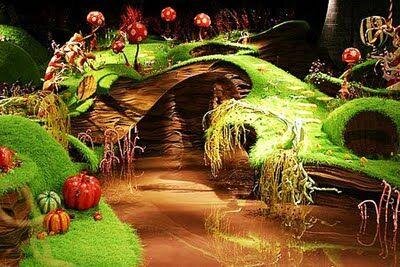
Figure 5
As I mentioned before, buildings, monuments, and any design need ahead, a brain that creates all the ideas and makes them happen. But in other to build these ideas, these concepts, is necessary for the help of the hands, the people who make this possible, the workers. In the film Metropolis, we see that a heart is also necessary to unify the head and the hands and have a harmonic life. All these are happening in Charlie and the Chocolate Factory movie, the head is Willy Wonka, the owner of the factory, the brain of the creation of candies and chocolates, the hands are the workers, the Oompa-Loompas, who help Willy with the creation of the candies and help him to run the factory and all the machinery necessary to make the factory to function, without them, the success was not possible. Finally, the heart is Charlie, the winner of the great prize. I know that Willy Wonka and the Oompa-Loompas were already friends, and had a good relationship, but when Charlie comes to the factory, everything started to be better. Charlie helped Willy to continue having those great ideas and making better ones to continue with the success of the factory. In order to succeed in life, we need to have a head, hands and a heart and all this working together will make us have a better life. At the end of the film, we see that the family was important, but the most important thing was the old house. In this scene, we see that the past is a solution to the present (Sequential diagram). The director is telling us that the architecture of the past can be the solution to have a better future, but in real life it is fake, the film is a fake virtual world that showed us just a perfect ending. The story of Charlie and the Chocolate Factory, began at Charlie’s house, with a dream of something big, and its end at the same house just in a different location, inside the factory, where the heart and love were the only things that matter to have a happy life.
Films are being produced to show us fantasies, magic, and that anything can be possible, the movies make our world a better place to live. We all know that films are magic and give us the idea that if something is going bad, someday it will change. Like in Charlie and the Chocolate Factory, Charlie is kind, humble and had a huge heart and all those qualities will make him win a great prize and have a better future for him and his family. But in real life, we know that even if we are kind, humble and with a huge heart we have not assured a better future, in real life we need to fight more in order to win our own prize in life. Charlie and the Chocolate Factory showed a fantastic story in which capitalization is showed with the obsession of things, like technology, food, creation, and inventions, where we see a perfect world inside the factory and where the past is the solution for the future. Here, I learned that all those things outside are just important because we make them important, that obsessions are not healthy and that we need to find other forms to fill out our interior needs. Furthermore, it taught me that the architecture legacies are represented in films to show the importance of the monuments, in this case, the factory and how the love is big enough to create solutions to our problems. Films are here to give us hope of a better future, and that anything can be possible if we fight for it.
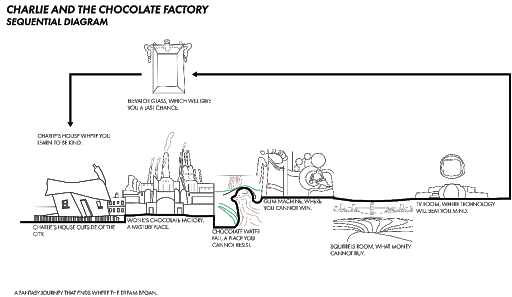
Figure 1
Bibliography
Allen, Stan. “Dazed and Confused.” Assemblage, no. 27 (1995): 47-54.
Alvarado, Asucena. Sequential Diagram. 2019.
Berlin, Symphony of Great City. Directed by Walter. Ruttmann. Weimar Republic: Fox Film Corporation. 1927. DVD.
Blade Runner. Directed by Ridley. Scott. The United States. Warner Bros: 1982. DVD.
Charlie and the Chocolate Factory. Directed by Tim. Burton. The United States. Warner Bros. Pictures: 2005. DVD.
Image source: Google, copyright-free image under Creative Commons License.
Metropolis. Directed by Fritz. Lang. Germany. Parufamet: 1927. DVD.
The Cabinet of Dr. Caligari. Directed by Robert. Wiene. Weimar Republic: Decla-Bioscop. 1920. DVD.

LOGO DESIGNED BY MEENTS ILLUSTRATED
from REVIEW BLOG - Every Movie Has a Lesson https://ift.tt/36fDR7r







No comments:
Post a Comment